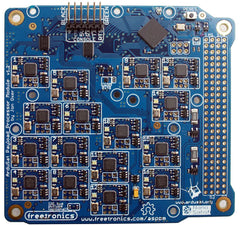LibreSat Payload Processor Module
The most powerful Arduino-compatible board in the world (or out of it!) has now landed.
Use it to build your own satellite for your classroom or hackerspace, or for an amazing multi-processor Arduino project.
The LibreSat Payload Processor Module (LSPPM) is 17 Arduino-compatible boards all squashed into one. This board was the brain of payloads for the ArduSat-X and ArduSat-1 satellites that were launched into space in 2013, designed to run multiple simultaneous experiments in Low-Earth Orbit.
The LSPPM features one supervisor processor consisting of an ATmega2561 (similar to an Arduino Mega) plus 16 processor nodes each running an ATmega328P just like an Arduino Uno. The role of the supervisor is to provide mass storage on the Micro SD card for all processor nodes; power down any nodes not in use; receive new sketches to execute on nodes, and send them to the appropriate node via the serial connection; provide debug information on the serial debug console; and monitor power consumption on the 5V and 3.3V rails.
Sketches can be loaded into the individual processor nodes by the supervisor, which is connected to all their UARTs via multiplexers and to their reset lines using an addressable latch. The nodes themselves think they are regular Arduino compatible boards, and the supervisor acts in place of the Arduino IDE to send new sketches to them after asserting their reset line.
Sketches can also be loaded manually into each processor node using an ICSP programmer such as a USBasp or an AVR ISP Mk 2, just like a regular Arduino.
You can even stack these modules to create powerful but compact Arduino-compatible processor arrays with 32, 48, 64 etc MCUs.
Features
- 16 x processor nodes, each with an ATmega328P MCU
- Each processor node runs the Arduino bootloader
- 1 x supervisor node with an ATmega2561
- Micro SD card slot connected to supervisor
- All MCUs and sensors on a shared I2C bus
- All I2C devices use bidirectional isolation circuits to allow continued operation of the system with failed devices
- Processor node UARTs connected via multiplexers to the supervisor's first UART
- 5V serial debug console with standard FTDI-style pinout on supervisor's second UART
- Each processor node can be powered down independently by the supervisor
- Each processor node can be reset using an I2C latch by the supervisor
- Each MCU has an independent crystal for maximum reliability
- TX, RX, and D13 LEDs on every processor node
- Top and bottom temperature sensors on I2C bus with "disable" option to prevent address collisions
- Requires external 5V and 3.3V supply
- Current consumption monitoring of both power rails by the supervisor
- Stackable CubeSat bus connectors
- Conforms to CubeSat mechanical standards for dimensions and mounting
- Selectable power bus connections
- Optional I2C satellite bus pull-ups
- I2C headers for spectrometer, Geiger counter, and bottom plate sensor assembly
- GPS header with UART connections to node 11 via 3.3V level shifters
- Switchable power supply to GPS header controlled by supervisor
- Supplied with stackable CubeSat Bus connectors
Specifications
- Dimensions: 95.45mm x 90.3mm
- PCB material: FR4 fibreglass (requires out-gassing before vacuum use)
- PCB connections: ENIG (electroless nickel immersion gold)
- Module mass: 37 grams
- Connector mass (pair): 15 grams
- Total assembled mass including solder: 54 grams
Resources
- ArduSat website
- CubeSat website
- CubeSat Design Specifications (PDF)
- ArduSat section of the Freetronics Forum
- CubeSat Bus pinouts for ArduSat missions (soon)
- ASPPM design files on GitHub
Note: Supply of this board to some countries may be restricted for legal reasons.
SKU:
- ASPPM (0)















